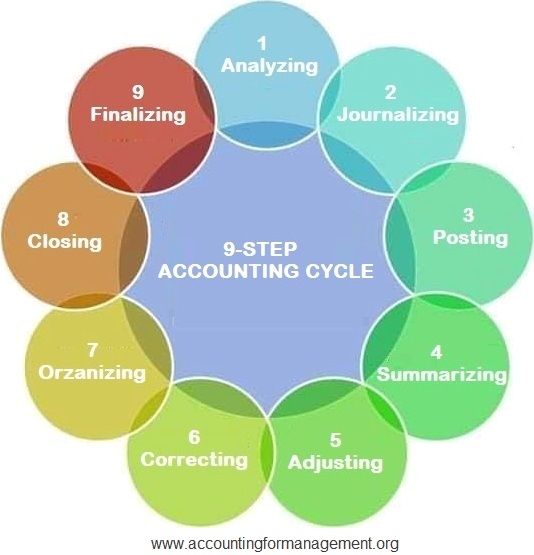
It indicates that firms have created all financial statements, and recorded, analyzed, and summarized all business transactions thoroughly. With the closure of the books, however, the bookkeepers and accountants repeat the accounting steps for the next accounting period. The accounting process consists of activities involved in preparing financial statements and includes identifying, recording, and summarizing a business’s financial transactions.
Try accounting software to lighten the load
Some of the best forensic accountants have put away major criminals such as Al Capone, Bernie Madoff, Ken Lay, and Ivan Boesky. Adjusting entries are prepared to update the accounts before they are summarized in the financial statements. After closing, the accounting cycle starts over again from the beginning with a new reporting period. Closing is usually a good time to file paperwork, plan for the next reporting period, and review a calendar of future events and tasks.
What Is the Difference Between the Accounting Process and the Accounting Cycle?
Creating an accounting process may require a significant time investment. Setting up an effective process and understanding the accounting cycle can help you produce financial information that you can analyze quickly, helping your business run more smoothly. Identifying and solving problems early in the accounting cycle leads to greater efficiency. It is important to set proper procedures for each of the eight steps in the process to create checks and balances to catch unwanted errors. Transactional accounting is the process of recording the money coming in and going out of a business—its transactions.
Step 5: Prepare an adjusted trial balance
- This position will need to retrace the steps a suspect may have taken to cover up fraudulent financial activities.
- After closing, the accounting cycle starts over again from the beginning with a new reporting period.
- Transactional accounting is the process of recording the money coming in and going out of a business—its transactions.
- Closing entries offset all of the balances in your revenue and expense accounts.
At the end of the accounting period, some expenses may have been incurred but not yet recorded in the journals. Analyzing a worksheet and identifying adjusting entries make up the fifth step in the cycle. A worksheet is created and used to ensure that debits and credits are equal.
The federal government’s fiscal year spans 12 months, beginning on October 1 of one calendar year and ending on September 30 of the next. FY 2023 starts on October 1, 2022 and ends on September 30, 2023. After the adjusting entries have been passed and posted to respective ledger accounts, the 9 3 describe the types of responsibility centers unadjusted trial balance needs to be corrected to show the impact of these adjustments. For this purpose, an amended trial balance, known as an adjusted trial balance, is prepared. After determining the accounts involved, the next step is to journalize the transaction in a journal book.

If this occurs, accountants may have to go all the way back to the beginning of the process to find their error. Make sure that as you complete each step, you are careful and really take the time to understand how to record information and why you are recording it. In the next section, you will learn how the accounting equation is used to analyze transactions.
A balance sheet can then be prepared, made up of assets, liabilities, and owner’s equity. In other words, deferrals remove transactions that do not belong to the period you’re creating a financial statement for. Learn how to build, read, and use financial statements for your business so you can make more informed decisions. Whether your accounting period is monthly, quarterly, or annually, timing is crucial to implementing the accounting cycle properly. Mapping out plans and dates that coincide with your accounting deadlines will increase productivity and results. Bookkeeping focuses on recording and organizing financial data, including tasks, such as invoicing, billing, payroll and reconciling transactions.
Whether you use a single entry accounting system or a double entry accounting system, applying a debit or credit to every transaction is necessary. Thus, the transactions move to a cash accounting system when money is paid or received. In short, all transactions that occur within an accounting period must find a record in a journal. When a transaction is recorded, it has to be posted to an account on the general ledger. Accounts have to do with business operations, as well as where money is moving. The general ledger allows bookkeepers to monitor a company’s financial position.
The next step in the accounting cycle is to post the transactions to the general ledger. Think of the general ledger as a summary sheet where all transactions are divided into accounts. It lets you track your business’s finances and understand how much cash you have available. The general ledger is a central database that stores the complete record of your accounts and all transactions recorded in those accounts. The first step of the accounting cycle is to analyze each transaction as it occurs in the business. This step involves determining the titles and nature of accounts that the transaction will affect.
Adjusting entries are made at the end of an accounting period to adjust those accounts that need to be updated or adjusted. Adjustments include the recording of depreciation expense, the gradual release of prepayments, and the recording of earned revenue from unearned revenues at the end. When you record all transactions in the general journal, now, is the time to post these all transactions in the appropriate T account (General Ledger). They are prepared at the beginning of the new accounting period to facilitate a smoother and more consistent recording process, especially if the company uses a cash-basis accounting system. Simply put, the ledger collates all records made to specific accounts.
